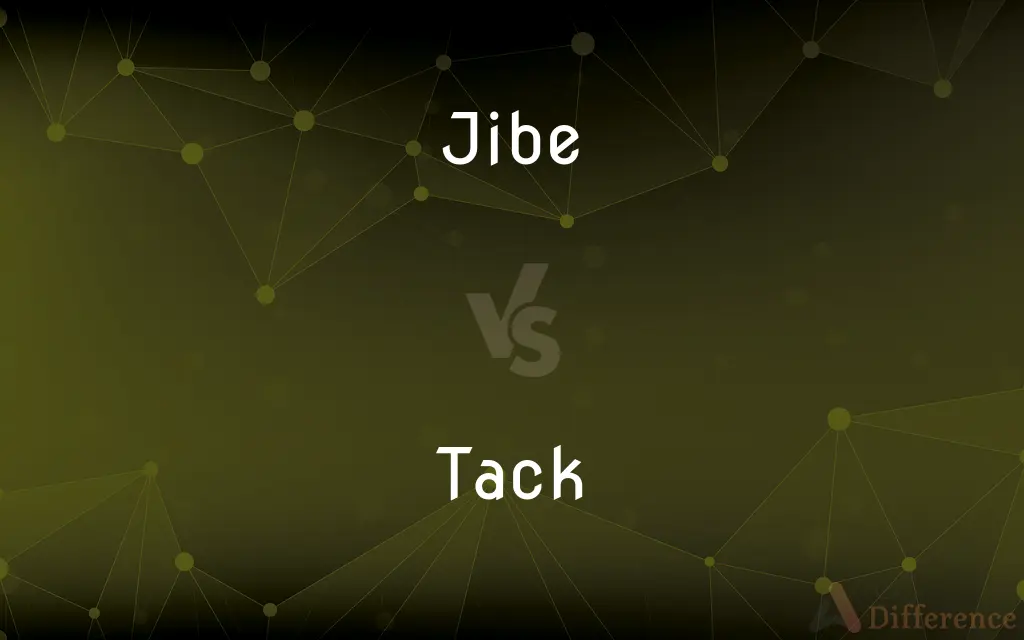Jibe vs. Tack — What's the Difference?
By Tayyaba Rehman & Fiza Rafique — Updated on March 26, 2024
Jibing involves turning the stern through the wind in sailing, while tacking turns the bow through the wind.

Difference Between Jibe and Tack
Table of Contents
ADVERTISEMENT
Key Differences
Jibing and tacking are two fundamental sailing maneuvers used to change a boat's course relative to the wind. Jibing involves turning the stern (the back of the boat) through the wind, making the wind shift from one side of the boat to the other with a sweeping motion. On the other hand, tacking involves turning the bow (the front of the boat) through the wind, effectively changing the wind's direction from one side of the boat to the other more abruptly.
While jibing is typically performed when the wind is behind the boat, making it a downwind maneuver, tacking is executed when sailing upwind, requiring the boat to zigzag in a series of turns to progress against the wind. The choice between jibing and tacking depends on the desired direction of travel relative to the wind and the sailing conditions.
Jibing, due to the wind pushing against the sail from behind, can be a faster maneuver but is also considered riskier, especially in strong winds, because of the potential for uncontrolled sail movement or accidental jibing. Tacking, although generally safer and more controlled, requires careful timing and coordination among the crew to efficiently change the sail's side without losing much speed.
In terms of technical execution, jibing requires managing the sail as it sweeps across the boat, often necessitating adjustments to the sail's angle and tension to prevent accidental or dangerous swings. Tacking, in contrast, involves a coordinated effort to quickly shift the sails and the boat's heading to ensure a smooth transition through the wind.
The choice of maneuver, jibe or tack, significantly affects a sailing vessel's strategy and safety. Sailors must consider factors such as wind strength, wave conditions, and their vessel's characteristics when deciding which maneuver to execute. While jibing allows for a rapid downwind course change, tacking enables sailors to navigate upwind, each technique offering distinct advantages and challenges in navigating the seas.
ADVERTISEMENT
Comparison Chart
Definition
Turning the stern through the wind.
Turning the bow through the wind.
Wind Direction
Downwind maneuver.
Upwind maneuver.
Risk Level
Higher, especially in strong winds due to potential for uncontrolled sail movement.
Generally safer and more controlled.
Execution Speed
Can be faster due to wind pushing sail from behind.
Can be slower, requiring zigzagging against the wind.
Technical Requirements
Managing sail angle and tension to prevent accidental swings.
Coordinating sail shift and boat heading for a smooth wind transition.
Compare with Definitions
Jibe
The act of changing course by bringing the stern through the wind.
The captain called for a jibe to take advantage of the shifting wind.
Tack
A sailing maneuver where the bow crosses through the wind.
They tacked repeatedly to make headway against the upwind challenge.
Jibe
A sailing maneuver where the stern passes through the wind.
They executed a perfect jibe, swiftly changing direction with the wind at their back.
Tack
The act of changing direction by turning the bow through the wind.
Tacking in tight quarters requires precise steering and timing.
Jibe
A method used in sailing to turn the boat with the wind behind.
Learning to jibe safely is crucial for handling strong winds.
Tack
The process of shifting the sail from one side to the other while turning the boat's front through the wind.
As the wind shifted, they prepared to tack to maintain their course.
Jibe
A technique in sailing for rapid downwind course changes.
Their strategy relied on a series of quick jibes to outmaneuver the competition.
Tack
A technique in sailing for navigating against the wind's direction.
Their upwind leg was marked by a series of tactical tacks.
Jibe
The process of shifting the sail from one side of the boat to the other in a downwind direction.
The crew prepared the sail for the jibe, anticipating the wind's force.
Tack
A method used in sailing to progress upwind by zigzagging.
Mastering the art of tacking is essential for efficient upwind sailing.
Jibe
A jibe (US) or gybe (Britain) is a sailing maneuver whereby a sailing vessel reaching downwind turns its stern through the wind, which then exerts its force from the opposite side of the vessel. For square-rigged ships, this maneuver is called wearing ship.
Tack
A short, light nail with a sharp point and a flat head.
Jibe
To shift a fore-and-aft sail from one side of a vessel to the other while sailing before the wind so as to sail on the opposite tack.
Tack
A rope for holding down the weather clew of a course.
Jibe
To cause (a sail) to jibe.
Tack
A rope for hauling the outer lower corner of a studdingsail to the boom.
Jibe
To be in accord; agree
Your figures jibe with mine. See Usage Note at jive.
Tack
The part of a sail, such as the weather clew of a course, to which this rope is fastened.
Jibe
Variant of gibe.
Tack
The lower forward corner of a fore-and-aft sail.
Jibe
The act of jibing.
Tack
The position of a vessel relative to the trim of its sails.
Jibe
A facetious or insulting remark; a jeer, a taunt.
He flung subtle jibes at her until she couldn’t bear to work with him any longer.
Tack
The act of changing from one position or direction to another.
Jibe
Alternative spelling of gybe
Tack
The distance or leg sailed between changes of position or direction.
Jibe
(transitive) To reproach with contemptuous words; to deride, to mock, to taunt.
Tack
An approach to accomplishing a goal or a method of dealing with a problem.
Jibe
(transitive) To say in a mocking or taunting manner.
Tack
A large, loose stitch made as a temporary binding or as a marker.
Jibe
(intransitive) To make a mocking remark or remarks; to jeer.
Tack
Stickiness, as that of a newly painted surface.
Jibe
To accord or agree.
That explanation doesn’t jibe with the facts.
Tack
Food, especially coarse or inferior foodstuffs.
Jibe
Alternative spelling of gybe
Tack
The harness for a horse, including the bridle and saddle.
Jibe
To shift, as the boom of a fore-and-aft sail, from one side of a vessel to the other when the wind is aft or on the quarter. See Gybe.
Tack
To fasten or attach with a tack or tacks
Tacked the carpet down.
Jibe
To agree; to harmonize.
Tack
To fasten or mark (cloth or a seam, for example) with a loose basting stitch.
Jibe
An aggressive remark directed at a person like a missile and intended to have a telling effect;
His parting shot was `drop dead'
She threw shafts of sarcasm
She takes a dig at me every chance she gets
Tack
To put together loosely and arbitrarily
Tacked some stories together in an attempt to write a novel.
Jibe
Be compatible, similar or consistent; coincide in their characteristics;
The two stories don't agree in many details
The handwriting checks with the signature on the check
The suspect's fingerprints don't match those on the gun
Tack
To add as an extra item; append
Tacked two dollars onto the bill.
Jibe
Shift from one side of the ship to the other;
The sail jibbed wildly
Tack
(Nautical) To bring (a vessel) into the wind in order to change course or direction.
Tack
To change the direction of a sailing vessel, especially by turning the bow into and past the direction of the wind
Stand by to tack.
Tack
To sail a zigzag course upwind by repeatedly executing such a maneuver.
Tack
To change tack
The ship tacked to starboard.
Tack
To change one's course of action.
Tack
A small nail with a flat head.
Tack
A thumbtack.
Tack
(sewing) A loose seam used to temporarily fasten pieces of cloth.
Tack
(nautical) The lower corner on the leading edge of a sail relative to the direction of the wind.
Tack
(nautical) A course or heading that enables a sailing vessel to head upwind.
Tack
(figurative) A direction or course of action, especially a new one.
Tack
(nautical) The maneuver by which a sailing vessel turns its bow through the wind so that the wind changes from one side to the other.
Tack
(nautical) The distance a sailing vessel runs between these maneuvers when working to windward; a board.
Tack
(nautical) A rope used to hold in place the foremost lower corners of the courses when the vessel is close-hauled; also, a rope employed to pull the lower corner of a studding sail to the boom.
Tack
Any of the various equipment and accessories worn by horses in the course of their use as domesticated animals.
Tack
The stickiness of a compound, related to its cohesive and adhesive properties.
The laminate adhesive has very aggressive tack and is hard to move once in place.
Tack
Food generally; fare, especially of the bread kind.
Soft tack
Tack
That which is attached; a supplement; an appendix.
Tack
(obsolete) Confidence; reliance.
Tack
A stain; a tache.
Tack
(obsolete) A peculiar flavour or taint.
A musty tack
Tack
(colloquial) That which is tacky; something cheap and gaudy.
Tack
A contract by which the use of a thing is set, or let, for hire; a lease.
Tack
To nail with a tack small nail with a flat head.
Tack
To sew/stitch with a tack loose seam used to temporarily fasten pieces of cloth.
Tack
(nautical) To maneuver a sailing vessel so that its bow turns through the wind, i.e. the wind changes from one side of the vessel to the other.
Tack
To add something as an extra item.
To tack (something) onto (something)
Tack
To place the tack on a horse; often paired with "up".
Tack
A stain; a tache.
Tack
A peculiar flavor or taint; as, a musty tack.
Tack
A small, short, sharp-pointed nail, usually having a broad, flat head.
Tack
A rope used to hold in place the foremost lower corners of the courses when the vessel is closehauled (see Illust. of Ship); also, a rope employed to pull the lower corner of a studding sail to the boom.
Tack
A contract by which the use of a thing is set, or let, for hire; a lease.
Tack
Confidence; reliance.
Tack
To fasten or attach.
And tacks the center to the sphere.
Tack
Especially, to attach or secure in a slight or hasty manner, as by stitching or nailing; as, to tack together the sheets of a book; to tack one piece of cloth to another; to tack on a board or shingle; to tack one piece of metal to another by drops of solder.
Tack
In parliamentary usage, to add (a supplement) to a bill; to append; - often with on or to; as, to tack on a non-germane appropriation to a bill.
Tack
To change the direction of (a vessel) when sailing closehauled, by putting the helm alee and shifting the tacks and sails so that she will proceed to windward nearly at right angles to her former course.
Tack
The heading or position of a vessel relative to the trim of its sails
Tack
A short nail with a sharp point and a large head
Tack
Gear for a horse
Tack
(nautical) a line (rope or chain) that regulates the angle at which a sail is set in relation to the wind
Tack
(nautical) the act of changing tack
Tack
Sailing a zigzag course
Tack
Fasten with tacks;
Tack the notice on the board
Tack
Turn into the wind;
The sailors decided to tack the boat
The boat tacked
Tack
Make by putting pieces together;
She pieced a quilt
He tacked together some verses
Tack
Sew together loosely, with large stitches;
Baste a hem
Tack
Fix to; attach;
Append a charm to the necklace
Tack
Reverse (a direction, attitude, or course of action)
Common Curiosities
Why would sailors choose to tack instead of jibe?
Sailors tack to navigate upwind, a direction not directly possible with jibing, which is a downwind maneuver.
Can all sailboats perform both jibing and tacking maneuvers?
Yes, all sailboats can perform both maneuvers, but the ease and safety with which they do so can vary based on the boat's design and the wind conditions.
Is jibing more dangerous than tacking?
Yes, jibing can be riskier due to the potential for uncontrolled sail movement, especially in strong winds.
What are the key skills needed for successful jibing?
Successful jibing requires managing sail tension and angle to prevent accidental swings and ensuring the maneuver is executed safely.
How do wind conditions affect the choice between jibing and tacking?
Strong winds may make jibing more hazardous, while light winds might require more frequent tacking to maintain speed.
What preparations are necessary before executing a jibe or tack?
Preparations include adjusting the sails, ensuring the crew is ready, and the boat is properly aligned for the maneuver.
How do sailors decide when to jibe or tack?
Decisions are based on the desired course, wind direction, and sometimes strategic considerations in racing or navigation challenges.
What is the primary difference between jibing and tacking?
Jibing involves turning the stern through the wind (downwind maneuver), while tacking turns the bow through the wind (upwind maneuver).
Is there a preferred side to jibe or tack?
The preferred side depends on the wind direction and the desired course, not on the maneuver itself.
Can jibing or tacking cause damage to a sailboat?
If performed incorrectly, especially in strong winds, both maneuvers can cause damage to the sails or rigging.
What is the advantage of tacking in a race?
Tacking allows sailors to make progress upwind, essential in races where upwind legs are part of the course.
Why is tacking considered a fundamental sailing skill?
It's essential for upwind sailing, which requires skillful navigation and boat handling to progress against the wind.
How does boat size affect jibing and tacking?
Larger boats may require more coordination and time to execute these maneuvers safely due to their mass and sail area.
Share Your Discovery

Previous Comparison
Maghrib vs. Maghreb
Next Comparison
Koppie vs. KopjeAuthor Spotlight
Written by
Tayyaba RehmanTayyaba Rehman is a distinguished writer, currently serving as a primary contributor to askdifference.com. As a researcher in semantics and etymology, Tayyaba's passion for the complexity of languages and their distinctions has found a perfect home on the platform. Tayyaba delves into the intricacies of language, distinguishing between commonly confused words and phrases, thereby providing clarity for readers worldwide.
Co-written by
Fiza RafiqueFiza Rafique is a skilled content writer at AskDifference.com, where she meticulously refines and enhances written pieces. Drawing from her vast editorial expertise, Fiza ensures clarity, accuracy, and precision in every article. Passionate about language, she continually seeks to elevate the quality of content for readers worldwide.
















































